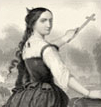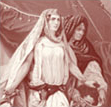


Collective Biographies of WomenAn Annotated Bibliography
Alison Booth
15.
Adams, William Henry Davenport. Women of Fashion and Representative Women in Letters and Society: A Series of Biographical and Critical Studies. 2 vols., London: Tinsley, 1878.
Search OCLC WorldCat for this title.
Search Google Books for this title.
Adams, William Henry Davenport. Women of Fashion and Representative Women in Letters and Society: A Series of Biographical and Critical Studies. 2 vols., London: Tinsley, 1878.
TOC: Lady Mary Wortley Montagu; The Duchess of Marlborough; Lady Morgan; Madame d'Arblay [Fanny Burney]; Mrs. Elizabeth Inchbald; The Countess of Blessington; Charlotte Brontë; Miss Berry.
Cambridge University Library stamp 23 Aug 78; labels of spines XXVIII 66 22 and 23. Blue
cloth 8o; black scrollwork stamps on covers, gilt lettering on spine, black lettering on
cover; brown floral endpapers. Davenport is identified as Author of "The Artic World, the
Mediterranean Illustrated, the Bird-World, etc." Dedicated "The the Right Hon. the Countess
of Glasgow these volumes are by permission respectfully and gratefully dedicated by the
author."
Adams's Preface submits to “'general reader’” reading that should be “pleasant and not
unprofitable” for “leisure hour,” concerning “the character of Woman as she appears in the
world of Literature and Society” (capitalized in original). The subjects were “chosen
because they are representative." It is "needless to dwell on the strong moral and
intellectual distinctions which separate a Harriet Martineau from a Lady Mary Wortley
Montagu, or a Charlotte Brontë from a Countess of Blessington.” umlaut The “present volumes
are confined to English Representative Women; but should they meet with a favourable
reception from the reading public, the writer on another occasion may venture further
afield.” "January 1878" (vii-viii)
Throughout biographies, a horizontal line sets off the header of each page, Representative
Women (verso), subject's name (recto). First page of each gives subject's name in large caps
followed by a period and "A.D. 1753-1821" (Inchbald) or the appropriate birth and death
dates. The narratives are divided into chapters.
Lady Mary Wortley Montagu's biography consumes 149 pages, followed by a summary page in
smaller type giving her name, dates of birth (1690) and death (1762), quoting at length from
“Dallaway,” who favorably compares Montagu's learning with other women's. She “applied her
learning to improve her knowledge of the world…" She showed best in her "purity of style,
rather than in the ambition of displaying her acquirements…" She gave "grace of expression
and novelty to maxims…” (150). Other subjects do not receive such a concluding page "blurb."
For comparison, Burney or “Frances D’Arblay” [sic] receives five chapters (124 pp.).
The biography of Elizabeth Inchbald begins, “We have now to tell the story of a Woman who
in some respects may fairly be considered Representative, though she made no very
conspicuous figure in what is known as Society, and does not occupy a very high position in
the republic of Letters. Her life was more remarkable than her works, and her character is a
more interesting study than her life. Yet had she possessed less of marked individuality,
and had her career permitted fewer noticeable incidents, she must still have been remembered
as a dramatist of some ability, and a novelist of no mean order” (125)
“Marguerite, Countess of Blessington, once so famous in London Society, though now little
more than the shadow of a name, was the third child…" begins Blessington's biography (176).
Chapter iv:“Lady Blessington’s literary career was not, as we have seen, a successful one”
(253). After a slash on p. 263, “A few words may be added respecting Count D’Orsay" (263-4),
a unique supplement comparable to Dallaway's words on Montagu.
As to Adams's authority and objectivity, he gets some facts wrong and judges by strict
gender and religious standards. Charlotte Brontë's dates are given 1817-1855 instead of
1816-1855. The biography begins: "The Rev. Patrick Blundell, who afterwards assumed the name
of Brontë, was a native of the county of Down in Ireland” (265). The three sisters become
subjects: Charlotte's "life was so mixed up with the lives of her sisters, that the threads
cannot be wholly disentangled…." Perhaps with Gaskell in mind, Adams opines, "We are great
believers in the power of circumstances to shape and modify character; and we believe that
the sights and sounds…in our childhood produce each a strong impression” (266-7). “We feel
the breath of the strong Yorkshire breezes in her style….Haworth was hardly the place in
which a lyrist of the Thomas Moore stamp could have grown up and sung; hardly the place to
have nourished a ‘Wild Irish Girl’ or an ‘Evelina.’ But it was no unfitting home for a ‘Jane
Eyre’” (267). The biography concludes with Harriet Martineau’s famous obituary assessment of
Charlotte as having the “conscientiousness of a saint” (342).
In her own biography, Adams grants: “Harriet Martineau, as all will admit, was a
remarkable woman; remarkble by virtue of her mental endowments; remarkable for force of
character; remarkable in her long and active career; and remarkable in her ready acceptance
of the crude speculations of an inferior mind; but remarkable, beyond everything, for her
egotism” of "sublime proportions" (343). Adams quotes W. R. Greg, “Qu’elle avait le défauts
de ses qualités” (344), dwelling further on Martineau's denial of merit in other people and
her conviction that "the world...floated round her own individuality” (348). “As a novelist
she cannot be ranked with George Eliot, Charlotte Brontë, or even Mrs. Gaskell. Her strength
lay in logical force of statement and appositeness of illustration” (348). After this
extensive assessment of Martineau's standing, Adams states that his sketch of her life is
based on the
Autobiography
, which he faults: it is “amusing to perceive the evident belief that the reader
will dwell as eagerly as she herself dwelt upon even the minutest particulars of her
childhood” (349). “It would be uncharitable to criticize too severely the moribund
utterances of a woman in Harriet Martineau’s physical condition” (393). Agnoticism is a
“miserable creed” (393).
Search OCLC WorldCat for this title.
Search Google Books for this title.